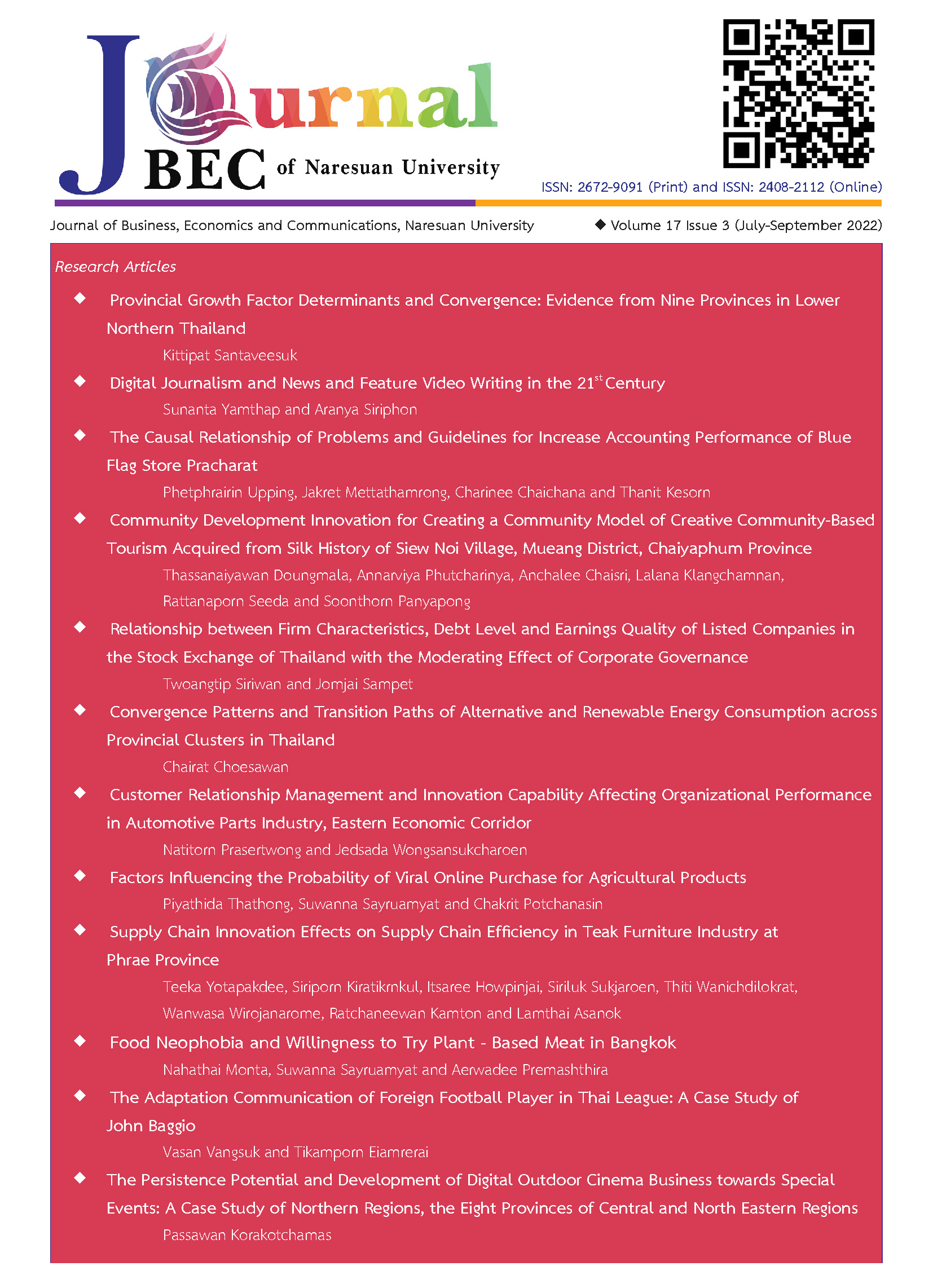Customer Relationship Management and Innovation Capability Affecting Organizational Performance in Automotive Parts Industry, Eastern Economic Corridor
Main Article Content
Abstract
The aim of this research is to empirically test a framework which identifies effect of customer relationship management and innovation capability that affected organizational performance in automotive parts industry in Eastern economic corridor. The research is quantitative research which was done by survey method using self administered questionnaires. The random samples were collected from 340 peoples who are operating in automotive part industry in EEC. Then all selected data were classified and analyzed by descriptive statistical method such as Frequency, Mean, and Standard Deviation including confirmation factors analysis (CFA) and structural equation modeling (SEM) for hypothesis testing.
The result found that the customer relationship management have directly influenced on the organizational performance with coefficient of 0.77 and have directly influenced on innovation capability with coefficient of 0.71. And have an indirectly influenced on the organizational performance through the mediator variable of innovation capability with coefficient of 0.16. Moreover, the innovation capability has directly influenced on organizational performance with coefficient of 0.23, all testing result significantly influenced is 0.001.
Article Details

This work is licensed under a Creative Commons Attribution-NonCommercial-NoDerivatives 4.0 International License.
References
Akroush., M. N., Dahiyat Samer, E., Gharaibeh H. S., and Abu-Lail B. N. (2011). Customer relationship management implementation: An investigation of a scale's generalizability and its relationship with business performance in a developing country context. International. Journal of Commerce and Management, 21(2), 158-191.
Battor, M., and Battor, M. (2010). The impact of customer relationship management capability on innovation and performance advantages: testing a mediated model. Journal of Marketing Management Science, 26(9-10), 842-857.
Damanpour., F. (1991). Organizational innovation: a meta-analysis of effects of determinants and moderators. Academy of Management Journal, 34(3), 555-590.
Evan, W. M. (1976). Organization Theory and Organizational Effectiveness: An Exploratory Analysis. Organization and Administrative Sciences, 7(1), 15-28.
Hair, J. F., Black, W. C., Babin, B. J., and Anderson, R. E. (2010). Multivariate Data Analysis (7th ed.). Upper Saddle River, New Jersey: Prentice Hall.
Huang, H. C., Chu, W., and Wang, W. K. (2007). Strategic performance measurement and value drivers: Evidence from international tourist hotels in an emerging economy. The Service Industries Journal, 27(8), 1112-1127.
Kaplan, R. S., and Norton., D. P. (1992). The balanced scorecard - measures that drive performance. Harvard business review, 70, 71-79
Kaplan, R. S., and Norton., D. P. (1996). Linking the balanced scorecard to strategy. In California management review, 39, 53-79.
Kaplan, R. S., and Norton., D. P. (2004). The strategy map: guide to aligning intangible assets. Strategy & Leadership, 32(5), 10-17.
Keramati, A., Mehrabi, H., and Mojir, N. (2010). A process-oriented perspective on customer relationship management and organizational performance: an empirical investigation. Industrial Marketing Management, 39(7), 1170-1185.
Lawson, B., and Samson, D. (2001). Developing innovation capability in organisations: a dynamic capabilities approach. International Journal of Innovation Management, 5(3), 377-400.
Liao, S. H., Fei, W. C., and Chen, C. C. (2007). Knowledge sharing, absorptive capacity, and innovation capability: an empirical study of Taiwan’s knowledge-intensive industries. Journal of Information Science, 33(3), 340-359.
Lin R.J., Chen, R. H., and Chiu, K. K. S. (2010). Customer relationship management and innovation capability:an empirical study. Industrial Management & Data Systems, 110 (1), 111-133.
McEvily, B., and Marcus, A. (2005). Embedded ties and the acquisition of competitive capabilities. Strategic Management Journal, 26(11), 1033-1055.
McPhail, R., Herington, C., and Guilding, C. (2008). Human resource managers' perceptions of the applications and merit of the balanced scorecard hotels. Journal Hospitality Management, 27(4), 623-631.
Mohr, J., and Spekman, R. (1994). Characteristics of partnership success: partnership attributes,communication behavior, and conflict resolution techniques. Strategic Management Journal, 15(2), 135-152.
Panayides, P. (2006). Enhancing innovation capability through relationship management and implications for performance. European Journal of Innovation Management, 9(4), 466-483.
Reinartz., W., Krafft, M., and Hoyer, W. D. (2004). The customer relationship management processes: its measurement and impact on performance. Journal of Marketing Research, 41(3), 293-305.
Sainaghi, R., Phillips, P., and Corti, V. (2013). Measuring hotel performance: Using a balanced scorecard perspectives' approach. International Journal of Hospitality Management, 34, 150-159.
Shane, S. A., and Ulrich, K. T. (2004). Technological innovation, product development, and entrepreneurship in management science. Management Science, 50(2), 133-144.
Sin, L. Y. M., Alan, C. B., and Yim F. H. (2005). CRM: conceptualization and scale development. European Journal of Marketing, 39(11/12), 1264-1290.
Smith, A. (2006). CRM and customer service: strategic asset or corporate overhead?. Handbook of Business Strategy, 7(1), 87-93.
Sorbon, D. (1996). LISREL 8 : User's Reference Guide: Scientific Software International.
Bohling, T., Bowman, D., LaValle, S., Mittal, V., Narayandas, D., Ramani, G., and Varadarajan, R. (2006). CRM Implementation: Effectiveness Issues and Insights. Journal of Service Research, 9(2), 184-194.
Ulrich, D. (1998). Measuring human resources: An overview of practice and a prescription for results. Human Resource Management: Published in Cooperation with the School of Business Administration, The University of Michigan and in alliance with the Society of Human Resources Management, 36(3), 303-320.
Valmohammadi, C. (2017). Customer relationship management: Innovation and performance. International Journal of Innovation Science, 9(4), 374-395.
Vorhies, D. W., and Harker, M. (2000). The capabilities and performance advantages of market-driven firms: an empirical investigation. Australian Journal of Management, 25(2), 145-171.
Weerawardena, J. (2003). Exploring the role of market learning capability in competitive strategy. European Journal of Marketing, 37(3/4), 407-429.
Chaengjenkit, C. (2005). Customer Relationship Management in IMC & CRM for Real Estate Business, Bangkok: Home Buyers Guide.
Rompho, N. (2010). A study of the relationship between the success of the organizational Performance measurement system and financial success. Journal of Accounting Professions, 6(16), 43-50
Vorakitphokatorn, R. (2004). Innovation management for manager (Vol.2) Bangkok: National Innovation Agency.
Research Center Bank of Ayutthaya. (August 2019). Auto Parts Industry Business Industry trend for 2019-21. Retrieved April 10, 2020, from https://www.krungsri.com/th/research/industry/industry-outlook/Hi-tech-Industries/Auto-Parts/IO/Industry-Outlook-Auto-Parts-19
National Innovation Agency. (2010). Innovation management for executives (Vol. 3)
National science and Technology development Agency. (2017). Feasibility Study for development Eastern Economic Corridor innovation area (pp. 8-10). Ministry of Science and Technology


